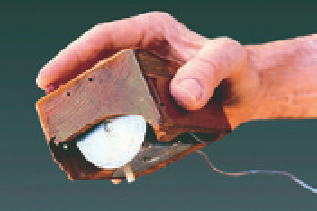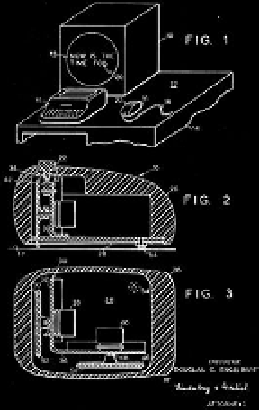Information Technology Reference
In-Depth Information
ARPA program set the precedent for providing the research base at four
of the first universities to establish graduate programs in computer sci-
ence: U.C. Berkeley, CMU, MIT, and Stanford. These programs, started in
1965, have remained the country's strongest and have served as role mod-
els for other departments that followed. Their success would have been
impossible without the foundation put in place by Lick in 1962-64.
29
Doug Engelbart and the mouse
Fig. 8.19. Doug Engelbart's mouse from
1967. This prototype mouse, invented
by Engelbart at the Stanford Research
Institute, rolled on two sharp wheels fac-
ing 90 degrees from each other.
On Engelbart's return home from military service in World War II,
he had been inspired by reading Vannevar Bush's visionary essay “As We
May Think,” published in 1945. Bush accurately foresaw the days when
scientists would be drowning in information:
Publication has been extended far beyond our present ability to make
real use of the record. The summation of human experience is being
expanded at a prodigious rate, and the means we use for threading
through the consequent maze to the momentarily important item is the
same as was used in the days of square-rigged ships.
30
Bush envisioned a machine he called the “memex”: “a device in which
an individual stores all his topics, records, and communications, and
which is mechanized so that it may be consulted with exceeding speed
and flexibility.”31
31
In 1957, when Engelbart joined the Stanford Research
Institute (SRI), he was finally able to start realizing his dream of creating
a memex with funding initially from Bob Taylor, then at NASA, and later
from Licklider at ARPA. (See
Chapter 10
,
B.10.10
for a brief biography of
Taylor.)
Engelbart and his team are best known for their invention of the
mouse (
Fig. 8.19
), but they also pioneered many other features of the pres-
ent-day GUI, in which the user controls a cursor on the screen to select
options from menus, start programs by clicking icons, and perform other
operations. Engelbart was not sure why it was called a mouse: “None of
us would have thought that the name would have stayed with it out into
the world, but the thing that none of us would have believed either was
how long it would take for it to find its way out there.”
32
Engelbart's researcher, Bill English, created the first mouse out of a
hollowed-out block of wood with two small wheels that allowed the user
to control the movement of a cursor on the computer screen (
Fig. 8.20
). At
an event that has been called the “Mother of All Demos” at a major computing conference in San Francisco
in December 1968, Engelbart demonstrated his group's “electronic office” software, called NLS (short for oN
Line System), in which he introduced the mouse, video conferencing, word processing, a real-time editor, and
split-screen displays to the world. He also demonstrated a prototype of Bush's memex idea by showing how
the user could select a single word in a text document and be instantly linked to a second document. This
prototype was the first implementation of a
hypertext
system, which enables the user to jump from one docu-
ment to another, such as we now use daily on the World Wide Web. Butler Lampson and Peter Deutsch, both
early recruits to Xerox PARC, had worked part-time for Engelbart in the 1960s and were both influenced by
the vision of the NLS electronic office software and by the 1968 demo.
Fig. 8.20. Engelbart's “mouse patent”
drawings. The word
mouse
does not
appear in Engelbart's patent for the com-
puter pointing device. The knife-edged
wheels each rolled in just one direction,
transmitting movement information for
that direction. Each slid without turning
when the mouse was moved in the other
direction.




Search WWH ::

Custom Search